ISSN
2307–3489 (Print), ІSSN
2307–6666
(Online)
Наука
та прогрес транспорту. Вісник
Дніпропетровського
національного університету залізничного
транспорту, 2018, № 4
(76)
електричний
ТРАНСПОРТ
Електричний
транспорт
UDC
621.33:621.333
Т.
P. PAVLENKO1*,
v. m.
SHAVKUN2*,
v. i.
Skurikhin3*,
n. p.
lUKASHOVA4*
1*Dep.
«Electric
Transport»,
National University of Urban Economy in
Kharkiv, Marshala
Bazhanova St.,
17, Kharkiv, Ukraine, 61002,
tel. +38 (095) 485 40 16,
e-mail tpavlenkoskp@gmail.com,
ORCID 0000-0002-2356-4066
2*Dep.
«Electric
Transport»,
National University of Urban Economy in
Kharkiv, Marshala
Bazhanova St.,
17, Kharkiv, Ukraine, 61002,
tel. +38 (095) 142
90 00, e-mail
vm.shavkun@gmail.com.com,
ORCID 0000-0002-3253-1282
3*Dep.
«Electric
Transport»,
National University of Urban Economy in
Kharkiv, Marshala
Bazhanova St.,
17, Kharkiv, Ukraine, 61002,
tel. +38 (095) 745
31 77, e-mail
vladscu@gmail.com,
ORCID 0000-0001-7415-7105
4*Dep.
«Electric
Transport»,
National University of Urban Economy in
Kharkiv, Marshala
Bazhanova St.,
17, Kharkiv, Ukraine, 61002,
tel. тел. +38 (097)
255 73 80, e-mail
lukashova.natalya@gmail.com,
ORCID /0000-0002-5556-241X.
METHODOLOGY
OF DETERMINING THE PARAMETERS OF TRACTION
ELECTRIC motor
FAILUREs WHEN
OPERATING TROLLEYBUSES
Purpose.
The work is aimed to study the change in parameters of
traction electric motors of trolleybuses during operation and
improvement of the technical state control system, using modern
diagnostic methods.
Methodology. Solution of the
scientific problem is based on the control of technical state and
change in the parameters of traction electric motors in the process
of operation. For analysis of operational factors, we used the method
of mathematical statistics and probability theory. Mathematical
modelling and design of experiment, multifactor regression analysis
provides an assessment of the reliability of the electric traction
motor elements. Physical and statistical methods provide for research
and detection of patterns of influence of the factors that accelerate
the wear of parts. This allows us to generate models of system
reliability that take into account the influence of operational
factors on the reliability. Findings. As a result of the
studies we obtained quantitative characteristics of the reliability
of commutator and established that the failures of traction motors
make up 20% of all failures of electrical equipment. We analysed the
operation conditions of traction electric motors and determined the
failure distribution law N{mx,x},
which allows assessing the progression between gradual
failures. We obtained a mathematical model
characterizing the object operation. A generalized
equation of the
failure rate of
elements for traction electric
motor (TEM) was
found. We improved the estimation
methods of reliability of TEM element base that makes it possible to
determine the ETM lifetime taking into account the features of each
trolleybus. We established the failure rate of commutators using
physical and statistical methods. Originality. For the first
time, the choice of physico-statistical methods of simulation and
reliability calculation was substantiated. We determined the
regularities of change in parameters of the trolleybus traction
electric motor elements, which makes it possible to control the
processes of their wear in the operation conditions. We developed a
mathematical model for estimating the traction electric motor
reliability, based on a system analysis of the probabilities of
failures of subsystems to be diagnosed.
Practical value.
Based on the results of the study, we developed practical
recommendations for rational choice of diagnostic parameters of
traction motors. Their implementation at the enterprises of electric
transport will increase reliability of electric motors in general up
to 10%. It is proposed to use the results of the work in the
educational process and in the research work of students at the
Department of Electric Transport of the O.M. Beketov National
University of Urban Economy in Kharkiv. The developed methodology for
determination of parameters of traction electric motors when
operating trolleybuses allows assessing the reliability of any type
of trolleybus traction motor.
Keywords:
electric transport;
traction electric
motor; diagnosing;
operating reliability;
failure rate
Introduction
Trolleybuses are equipped with
traction electric motors of direct and alternating current, which
determine the functional purpose of the rolling stock as a whole.
The main task of the operation
of urban electric transport, in particular that of trolleybuses, is
to ensure uninterrupted process of transportation of passengers,
traffic safety on routes, as well as electrical safety.
Providing
the appropriate
level of
reliability of
traction
electric motors
is an
urgent task
that contributes
to the
efficiency of
urban electric
transport in
general [1].
It is possible to obtain the
solution of the problem by saving resources and controlling
parameters in the process of the object operation. This can be
achieved by ensuring the quality of maintenance and timely control
of the relevant parameters of the traction electric motors while
operating trolleybuses on routes. This set of tasks emphasizes the
relevance of the work [1, 2].
Purpose
The main purpose of the work is
to study the change in parameters of traction electric motors of
trolleybuses during operation and improvement of the technical state
control system, using modern diagnostic me.
According to the purpose of the
work, the following tasks are defined:
– To
study the
parameters of
traction
electric motors
of trolleybuses
in the
course of
their operation,
to obtain
quantitative
characteristics
of the
commutator
reliability and
to define
the failure
distribution
laws;
– To
establish the
mathematical
expectation of
the time
between failures
of the
commutator
elements;
To define
the commutator
wear rate
distribution law;
To
develop the
methods of
failure
prediction for
trolleybus
traction
electric motor
elements.
Solving these tasks will
increase the operational reliability of trolleybus traction electric
motors.
Methodology
The achievement of this purpose
is based on the control of technical state and change in the
parameters of traction electric motors in the process of operation.
Analysis of operational factors
is carried out using methods of mathematical statistics and
probability theory. To evaluate the reliability of traction electric
motor elements, the method of mathematical modeling and the design
of experiment are used.
The history of the development
and improvement of methods for assessing reliability allows to
distinguish two main stages: the study of statistical parameters and
analysis of physico-statistical cha-racteristics.
Comparison of methods in terms
of accuracy of the obtained parameters and the adequacy of simulated
processes makes it possible to highlight their features.
This allows us to form the
system reliability models that take into account the influence of
operational factors [1, 2].
The failures
of traction electric motors largely depend on the properties of the
design, materials, load modes and operating conditions.
Quantitatively, they
can be
estimated by
probabilistic-statistical
characteristics.
A significant
number of works is devoted to the issue of increasing the
reliability of traction electric motors (TEM) of trolleybuses [3-5,
9, 12, 13]. However, most of them do not meet the necessary
requirements to ensure maximum accuracy of assessment and forecast
during the trolleybus operation.
To diagnose electric motors of
trolleybuses, we determined the intensity of change in parameters,
which contributes to the disturbance of switching of the motors due
to the intense wear of the commutator. This phenomenon reflects a
deterministic process.
In
order to
determine the
intensity of
wear of
the traction
electric motor
commutators, we
carried out
the studies
in the
conditions of
trolleybus
operation in
Ukraine.
Herewith we took
into account
the geometry
of the
commutators and
the state
of the
contact surface.
These studies confirmed the well-known provisions on the random
nature of the wear intensity of the commutator.
Based on the
main property of inconsistent events, the sum of probabilities will
be equal to one. If the random variable x
is expanded at intervals, then it is possible to obtain probability
characteristics, or the failure distribution law.
According
to the
statistical
analysis, we
determined the
characteristics
of the
mathematical
expectations and
the commutator
wear intensity,
taking into
account the
state of
the contact
surface [9, 12].
Findings
The
studies have
shown that
in most
cases, the
wear of
commutators
obeys the
Gaussian
distribution law
N {mx,x}.
But the
influence of
operational
factors on
the
characteristics
can vary
with the
running time.
The form of the distribution of the
commutator wear Vc
from the
probability of scattering of the stagnant failures will be the
empirical dependencies shown in Fig. 1, with the corresponding
parameters тх
і and
 for different commutators.
for different commutators.
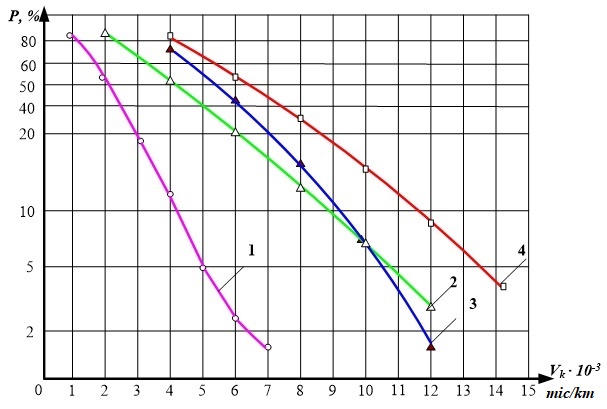
Fig. 1. Empirical
dependencies of distribution of the commutator wear rate:
1
– normal palette with black-out of plates; 2 – plate burning;
3
– abrasive destruction of the oxide film;
4
– circular and chaotic burning
If we accept
the change in the commutator wear intensity as a diffusion process,
then, after the end of the working period (in the stable period), it
fluctuates relative to a certain level. The time between failures T
in this case is determined by the formula [9, 12]:
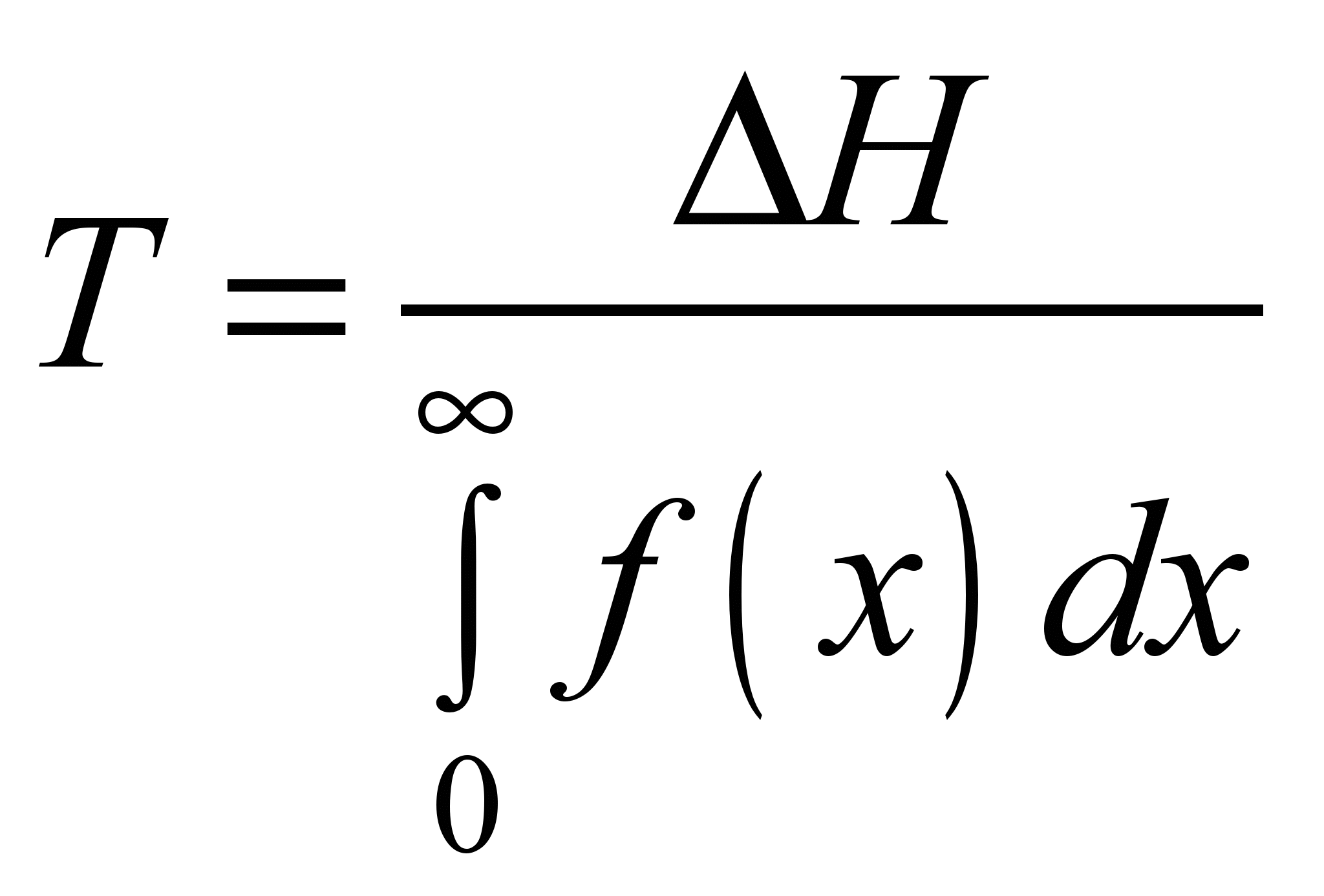 (1)
(1)
where
 –
allowable
value
of
wear,
μm;
–
allowable
value
of
wear,
μm;
 –
distribution density;
–
distribution density;
If the wear
of the commutator is subject to the Gaussian law, then the formula
will have as follows:
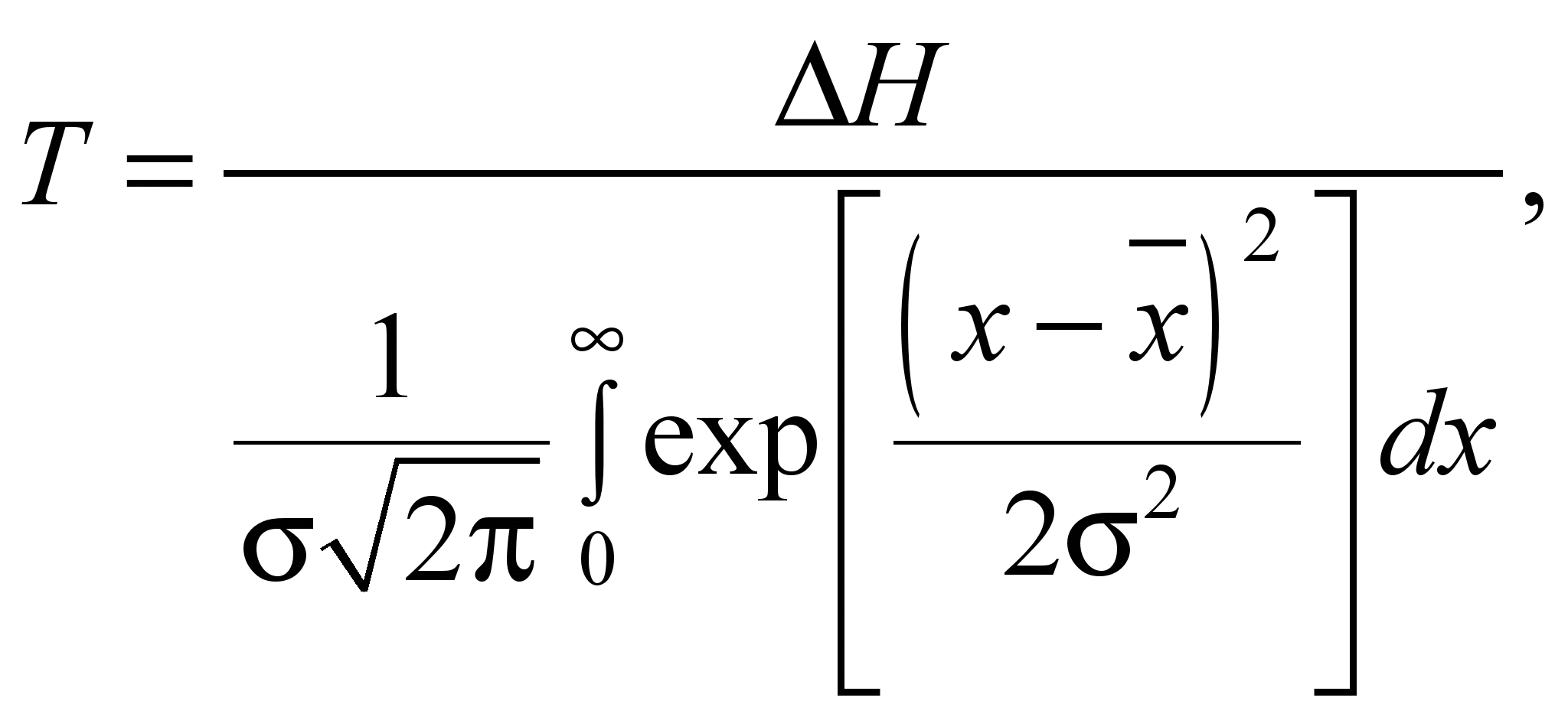 (2)
(2)
where
 –
mean square deviation;
–
mean square deviation;
 –
a random
variable;
–
a random
variable;
 – average
value of random variable.
– average
value of random variable.
Studying the
dispersion of the parameter P and
the characteristics of the commutator reliability, depending on the
state, showed that the contact surface may have a varied colour and
composition. The normal palette of plate surfaces has a uniform
oxide film without traces of erosion. The plate black-out or chaotic
burning shows the destruction of the contact surface by different
schemes.
In the case of plate burning
there is oxide film destruction, which affects the commutation
process and the reliability of the commutator unit. Results of the
study of pre-statistical characteristics of the commutator elements
wear are shown in Fig. 2

Fig.
2. Dependence of commutator reliability on the nature of its wear
Graphic dependencies demonstrate
the significant influence of the plate burning on the dispersion of
reliability characteristics.
In case of black-out or the
normal state of the oxide film, the dispersion level is almost two
times lower than that of commutators with plate burning.
In general, one can note the
following: the level of dispersion of the gradual failure of the
commutators is high, which requires the turning of the commutators
and practically complicates the combination with planned types of
technical inspections and repairs.
Practice
shows that
during TEM
operation
commutator
turning is
often performed.
This is explained, as was shown earlier,
by the magnitude of the spread of the mean time between failures.
The spread of the
characteristics of wear is mainly determined by the state of the
surface of the plates, the properties of the switching process,
vibration. Accelerated wear of commutators requires premature
turning, which is performed mainly during unscheduled repairs. Due
to frequent grinding, this group of commutators prematurely runs its
course.
But there is a group of
commutators that has low wear intensity. In this case, grinding
occurs during scheduled repairs when the parameters and condition of
the commutator allow it to be used until the next scheduled repair,
which involves reduction of the resource.
The results of studies are
important, which is that the deformation of the commutator during
operation is considered as a random process. This gives a
qualitative estimate of the change in the commutator geometry under
exploitation conditions.
The conducted studies allowed
determining the laws of changing the commutator geometry, depending
on the operating time and condition of the palette of different
types of traction electric motors. This confirms the increase in the
life of the commutators without having to be turned in the interval
between repairs.
The degree of wear of the
brushes depends on the state of the commutator working surface, the
armature and pole winding and the insulation (switching stages).
The wear of the brushes is based
on the fact that the destruction of individual areas of the friction
surface and the separation of the material in the form of wear
products is due to repeated interaction of the projections of rough
friction surfaces. Interaction of friction surfaces is accidental.
Consequently, the microgeometry can be determined only by means of
the functions of the distribution of surface areas at the height by
the reference curves.
Since the projections on
surfaces have different height and shape, then the magnitude of the
stresses and deformations that arise during the interaction will
also be characterized by a certain spectrum. This allows us to
determine that the process of destruction from weariness can be
considered accidental.
The condition
of friction pair «commutator-electrical brush» is characterized by
a certain set of loads, speeds and other parameters that have a
significant effect on their wear. Significant
impact on
wear is
also caused
by specific
pressure of
the brush
springs on
the brushes.
As the practice of exploitation shows, the
wear of electro-brushes of different types has significant
deviations of pre-statistical characteristics. The fig. 3 shows the
graphic dependences of the of wear rate of the brushes of different
types V
on the probability of dispersion of the gradual failure of the
brushes.
Taking
into account
the statistical
data, we
determined the
mathematical
expectation, the
mean square
deviation, and
the variance
of the
intensity of
the wear
of the
brushes [9,
12-14]. This makes it possible to make a
comparative analysis of various variants of assembly units of
commutators. However, in practice, the combination with planned
types of technical inspections and repairs is complicated.
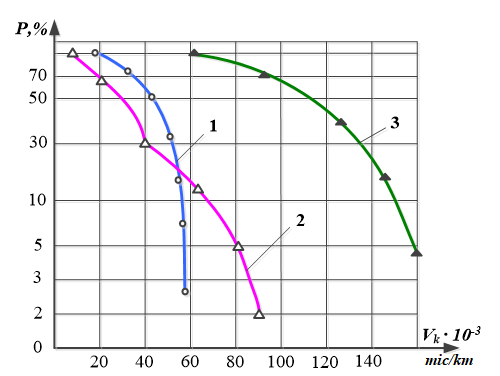
Fig. 3. Dependence
of wear rate of the brushes of different types:
1
– wear distribution curve of EG-2A type brushes; 2
– wear distribution curve of EG-62 type brushes;
3
– wear distribution curve of EG-74C type brushes
The value of the mean square
deviation of the wear intensity indicates a high degree of
dispersion of the reliability parameters (see Fig. 3). From the
given data it is seen that the time between failures is
characterized by a high level of dispersion for uneven wear. This
indicates that the failure of the brushes occurs between the
repairs, which creates the preconditions for unscheduled work to
eliminate failures and increases operating costs.
Thus, a decrease in the
dispersion between failures will allow concentrating the change of
brushes of ultimate wear on scheduled repairs.
As the practice of trolleybus
traction electric motors shows, the failures of system elements can
be caused by the inconsistency of load factors affecting the
increased wear. Such influence extends to each element of the system
separately or together, and levels can take different values.
Temporary and quantitative characteristics depend on operating
conditions, under which such factors as ambient temperature,
barometric pressure, pollution, frost, snow, etc. operate.
The factors
that affect the elements of the traction electric motors include
temperature, vibration, current, voltage, power, humidity, frequency
of rotation; we denote them as
 .
The part of these factors under operating
conditions varies depending on load modes and affects accordingly
the elements of traction electric motors.
.
The part of these factors under operating
conditions varies depending on load modes and affects accordingly
the elements of traction electric motors.
The failure rate with factors of
influence[9–12]:
 , (3)
, (3)
where
 –
variable parameter depending on the operating conditions;
–
variable parameter depending on the operating conditions;
 –
load factor
–
load factor
 ;
;
 –
coefficient
with regard to the properties of the design of the traction electric
motor, the state of gap in the joints of parts;
–
coefficient
with regard to the properties of the design of the traction electric
motor, the state of gap in the joints of parts;
 – influence
factors with
regard to
current,
vibration,
power, voltage,
etc.
– influence
factors with
regard to
current,
vibration,
power, voltage,
etc.
The
fig. 4 shows
the dependence
of the failure rate of the insulation for
traction electric motors
on the
nominal value
of the
load mode
fiH.
Dependencies are
constructed for
different
implementations
of the
load factor
c (с1
= 0.073;
с2
= 0.146;
с3
= 0.219;
с4
= 0.299;
с5
= 0.365;
с6
= 0.438;
с7
= 0.511).
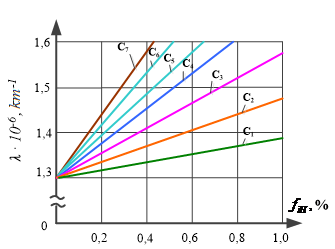
Fig. 4. Dependences
of failure rate of the traction electric motor isolation
on the nominal value
of loading mode fiH and
various realizations of the load factor c
The shown factors are
independent and operate simultaneously. Failure of an element due to
one of the factors leads to system failure.
The
dependence of
the failure
rate of
the traction
electric motor
element on
the failure
rate by
factors is
taken linear
and has
the form:

or
 (4)
(4)
Numerous
studies [3–8, 10–12] and operational data show the distribution
law for the probability of failure-free operation for some elements
of the traction electric motor. For relaxation failures in time t
this is a product with the parameter
 , This
parameter is determined taking into account the normal law of the
distribution of failures
, This
parameter is determined taking into account the normal law of the
distribution of failures
 Then
the reliability
of Pk
(t)
element for
the independence
of the
parametric
Then
the reliability
of Pk
(t)
element for
the independence
of the
parametric
 and the
relaxation
and the
relaxation
 failures
will be equal to the product:
failures
will be equal to the product:
 , (5)
, (5)
where

 (6)
(6)
Based on the
data (see Fig. 4), for the given value of the load factor c,
the reliability character-ristics for the assembly element are
calculated:
m1
=
3.810-4;
1
= 510-4;
c1
= 0.776;
m2
=
1.110-4;
2
=
1.710-4;
c2
= 0.742;
m3
=
1.710-4;
3
=
2.610-4;
c3
= 0.736.
From the given dependencies it
is clear that the parameters of the composite structure of the model
significantly affect the reliability of the traction electric motor.
For
mk
=
mkH;k
=
kH;k
=
kH
the
equation (5) will look as follows:

Expression of the failure rate
for a particular structural scheme of an element will have the form:
 .
.
By making the appropriate
substitution, we can obtain the equation [16–18]:

 (7)
(7)
where
k
is
the
coefficient
taking
into
account
the
properties
of
the
traction
electric
motor
design,
namely
the
state
of
the
gap
in
the
part
joints;
Mn
is
a mathematical expectation;
The obtained
dependences for various load factors indicate that the effect on the
failure rate for a particular structural scheme of the element
k
is not the same (Fig. 5). In the general
case, the equation that binds the failure rate, the probability of
failure-free operation and derivative, depends on the load factors
and may have the following form:
 (8)
(8)
Thus, we have
an important condition under which the expression connects the
failure rate with the parameters of the load element.
To diagnose
the technical condition of the turn and main insulation we take into
account the parameter change processes under the influence of the
heating temperature.
The
combination of changes in the factors influences the level and
nature of the TEM load.
During the
study of the reliability of the traction motor during operation, it
is important to provide an opportunity to analyze the reliability of
the insulation, taking into account the number of available factors.
Therefore, it
is important to have such a research scheme that would cover, if
possible, factors that are not significant, but in aggregate have a
great influence on the assessment of reliability parameters.
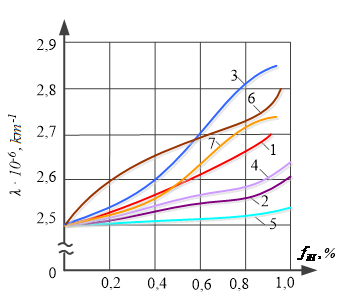
Fig.
5. Influence of load modes on the failure rate of insulation
of armature winding
for electric motors
against the nominal value of load mode fiH:
the curves 1–7
are load factors
We will show this for the
insulation of armature winding when determining the dependence of
the probability of failure-free operation of a system element on the
base space elements. To do this from the factor space elements we
select the base space elements.
Let
us suppose:
g1 is
the flow
rate of
the cooling
air from
0 to 80 m3/min;
g2 is
the voltage
from 0 to
700 V; g3
is the current
of 0 to
720 A; g4
is the air
humidity of
98 %.
In
the process
of research,
there are
some
difficulties in
choosing the
main factors.
Thus, the
temperature
depends on
the insulation,
which depends
on the
electrical,
magnetic,
mechanical
losses, and
they, in
turn, depend
on the
current, air
flow, the
frequency of
the armature
rotation, etc.
If we take into account that they are
correlated with each other to varying degrees, then the
formalization of the process will not take place. Therefore, only
factors of direct influence are taken into account, in particular
the temperature of heating of insulation, etc.
The
method of
multivariable
regression
analysis in
the presence
of statistics
that
characterizes
the work
of the
object, allowed
us to
obtain a
regression model
of temperature
dependence on
the base
space elements
and load
modes, taking
into account
the effects
of pressure:

 ,
(9)
,
(9)
where
х is a
random variable that has the form of the dependence of the
rotational frequency on the voltage g2
Then there will be an expression:

 (10)
(10)
By summing the similar and
transforming the right side (10) we obtain the equation:

 (11)
(11)
where
u0…u9
are the factor space elements.
The equation (11) characterizes
the dependence of temperature as an element of the factor space on
the strength of current, the flow of cooling air and voltage.
Similarly to the vibration
parameter, depending on the frequency of the armature rotation, we
have:
 . (12)
. (12)
Substituting
the obtained
expressions into
the basic
equation (7) of
the element
failures rate,
we obtain
a generalized
equation:

 ,(13)
,(13)
From
equation (13) we
find the
characteristics
of the
failure rate
against the
factors by
solving the
differential
equations of
the form:
 (14)
(14)
Thus we obtained the dependences
of the probability of failure-free operation on the temperature and
load modes.
The
calculation of
reliability made
it possible
to estimate
the level
of the
system element
failure rate,
which is
 The failure
rate when
exceeding the
factor levels
by 1.5 times
gives the
magnitude of
the failure
rate
The failure
rate when
exceeding the
factor levels
by 1.5 times
gives the
magnitude of
the failure
rate

The obtained results show that
in the presence of exploitation data, it is possible to predict the
failure rate by calculation and, based on the given service life, to
predict the probability of failure-free operation.
Consequently, it is possible to
predict the failure rate of all elements of traction electric motors
without exception and by using compositional models to determine the
reliability of the whole system.
Rational choice of diagnostic
parameters of traction motors will increase their reliability in
general up to 10%.
The
conducted
researches
provide the
basis for
further
development of
the
calculation-experimental
method for
estimating the
parameters of
the maintenance
system of
trolleybus
traction
electric motors,
which reached
the end
of their
assigned service
life.
The
proposal for
practical use
of the
method of
structural and
functional
analysis of
the reliability
of the
traction
electric motor
elements allowed
for the
particular
structural
assembly to
obtain adequate
estimates of
the reliability
parameters [9,
12].
These methods
allow making a calculation of
pre-statistical characteristics
parameters of failures and damages of parts and units, on the basis
of which it becomes possible to adjust the parameters of
inter-repair runs of the trolleybus traction electric motor as a
whole.
Originality and practical
value
For the first
time, the choice of physico-statistical methods of simulation and
reliability calculation was substantiated. We determined the
regularities of change in parameters of the trolleybus traction
electric motor elements, which makes it possible to control the
processes of their wear in the operation conditions. We developed a
mathematical model for estimating the traction electric motor
reliability, based on a system analysis of the probabilities of
failures of subsystems to be diagnosed.
Based on the results of the
study, we developed practical recommendations for rational choice of
diagnostic parameters of traction motors. Their implementation at
the enterprises of electric transport will increase reliability of
electric motors in general up to 10%.
It is proposed to use the
results of the work in the educational process and in the research
work of students at the Department of Electric Transport of the O.M.
Beketov National University of Urban Economy in Kharkiv.
The developed
methodology for determination of parameters of traction electric
motors when operating trolleybuses allows to assess the reliability
of any type of trolleybus traction motor.
Conclusions
1. As
a result of the conducted research we obtained the quantitative
characteristics of the commutator reliability. It has been
established that the failure of traction motors make up 20% of all
failures of electric equipment. Conditions
of operation
of traction
electric motors
were analysed.
We determined
the failure
distribution law
N
{mx,x},
which allows assessing the progression
between gradual failures.
2. We
obtained the mathematical model (9) using the multi-factor
regression analysis method in the presence of statistics. This model
characterizes the work of the object. We also obtained the
generalized equation of the failure rates (13) of the TEM elements.
We improved the method of estimating the reliability of the
elemental base of traction electric motors. The obtained solution
allows to determine the TEM service life taking into account the
characteristics of each trolleybus.
3. We
established the intensity of commutator wear using the distribution
law. The
calculation of
reliability
parameters
allowed to
estimate the
level of
the system
element failure
rate.
In case
of excess
of the
wear intensity
factors by
1.5 times the
parameter
 is changed by the value of
is changed by the value of

4. The
use of composite models and necessary calculation methods will allow
to predict the failure of elements of the trolleybus traction
electric motors. Practical recommendations, taking into account the
research results, will increase the reliability of TEM up to 10%.
LIST OF REFERENCE LINKS
Есаулов,
С. М. Исследование и разработка
зарядного устройства суперконденсатора
при рекуперации энергии торможения
электропривода на транспорте
/ С. М. Есаулов, О. Ф. Бабичева, Н. П.
Лукашова // Комунальне господарство
міст. Серія: Технічні науки та архітектура
: наук.-техн. зб. / Харк. нац. ун-т міськ.
госп-ва ім. О. М. Бекетова. – Харків,
2017. – Вип. 135. – С. 132–140.
Правила
експлуатації міського електричного
транспорту : навч. посіб. / В. Х. Далека,
В. Б. Будниченко, В. І. Коваленко, М. В.
Хворост, Л. О. Ісаєв ; Харк. нац. ун-т
міськ. госп-ва ім. О. М. Бекетова. –
Харків : ХНУМГ, 2014. – 447 с.
Разработка
и внедрение интеллектуальных систем
диагностирования технического состояния
электрического оборудования / С.
И. Лукьянов, А. С. Карандаев, С. А. Евдокимов
[и др.] // Вестн.
Магнитогор. гос. техн. ун-та им. Г. И.
Носова. – 2014. – № 1 (45).
– С. 129–136.
Розробка
енергомеханічної установки для тяги
електромобіля / Д. Ю. Зубенко, А. В.
Коваленко, О. М. Петренко, В. М. Шавкун,
М. Ю. Олехно // Science
Rise.
– 2016. – Т. 10, № 2 (27).
– С. 6–15.
doi:
10.15587/2313-8416.2016.79196
Рухомий
склад міського електричного транспорту.
Механічна частина : навч. посібник / В.
Х. Далека, М. В. Хворост, В. І. Скуріхін,
Д. І. Скуріхін. – Харків
: ХНУМГ імені О. М. Бекетова,
2018. – 370 с.
Скурихин,
В. И. Моделирование изнашивания
поверхностей трения узлов и деталей
машин / В. И. Скурихин // Проблеми та
перспективи розвитку технічних засобів
транспорту та систем автоматизації :
матеріали міжнар. наук.-техн. конф. –
Харків, 2014. – С. 42–43.
Сорока,
К. О. Змістовна модель та рівняння руху
електричного транспорту / К. О. Сорока,
Д. О. Личов // Наука та прогрес транспорту.
– 2015. – № 3 (57). – С. 97–106. doi:
10.15802/stp2015/46056
Сорока,
К. О. Система автоматизованого вибору
швидкісного режиму руху засобів
електротранспорту з метою зменшення
витрат електроенергії / К. О. Сорока,
Т. П. Павленко, Д. О. Личов // Наука
та прогрес транспорту. –
2017. – № 3 (69). – С. 77–91. doi:
10.15802/stp2017/104360
Технічна
експлуатація міського електричного
транспорту : навч. посіб. / В. Х. Далека,
В. Б. Будниченко, Е. І. Карпушин, В. І.
Коваленко
;
Харк. нац. ун-т міськ. госп-ва ім. О. М.
Бекетова. – Харків : ХНУМГ, 2014. – 236 с.
Шавкун,
В. М. Визначення оптимальних режимів
діагностування транспортних засобів
[Electronic
resource] / В.
М. Шавкун, О. В. Мізяк // Автомобіль і
електроніка. Сучасні технології.
– 2017. – № 12. –
С.
193–198. – Режим доступу:
http://www.khadi.kharkov.ua/fileadmin/P_SIS/AE17_2/5.2.pdf
– Назва з екрана. – Перевірено :
23.06.2018.
Шавкун,
В. Діагностування тягових електричних
машин електротранспорту / В. Шавкун //
Вост.-Европ. журн. передовых технологий.
– 2014. – Т. 1, № 7 (67). – С. 48–53.
Яцун,
М. А. Експлуатація та діагностування
електричних машин і апаратів / М. А.
Яцун, А. М. Яцун. – Львів : Львівська
політехніка, 2010. – 228 с.
Identification
of induction machine parameters using only no-load test
measurements /
M. Aminu,
P.
K. Ainah, M. Abana, U. A. Abu // Nigerian
Journal of Technology. – 2018. – Vol.
37. – Iss. 3. – P. 742–748.
doi:
10.4314/njt.v37i3.25
Kolcio,
K. Model-based
off-nominal state isolation and detection system for autonomous
fault management / K. Kolcio,
L. Fesq
// IEEE
Aerospace Conference Proceedings. – 2016. doi:
10.1109/AERO.2016.7500793
Kuznetzov,
A. Resource saving reserves of determining characteristics of the
long steering wall of wagon of the metro / A. Kuznetzov,
V. Skurikhin, V. Shavkun // EUREKA:
Physical
Sciences and
Engineering.
– 2018. – Vol.
1. – P. 19–28. doi:
10.21303/2461-4262.2018.00525
Pavlenko,
T. Ways
to improve operation reliability of traction electric motors of the
rolling stock of electric transport / T.
Pavlenko, V.
Shavkun, A.
Petrenko //
Eastern-European
Journal of
Enterpraise
Technologies. –
2017. – Vol.
5. – Iss. 8
(89). – Р. 22–30. doi: 10.15587/1729-4061.2017.112109
Zubenko,
D. Designing intelligent systems management transport enterprises
entropy approach / D. Zubenko,
A. Kuznetzov // EUREKA: Physics and
Engineering. – 2016. – Vol.
1. – P.
49–54.
doi:
10.21303/2461-4262.2016.00025
т.
п. пАВЛЕНКО1*,
в. м. шАВКУН2*,
в. і. сКУРІХІН3*,
н. п. лУКАШОВА4*
1*Каф.
«Електричний транспорт», Харківський
національний університет міського
господарства імені О. М. Бекетова, вул.
Маршала Бажанова, 17, Харків, Україна,
61002, тел. +38 (095) 485 40 16, ел. пошта
tpavlenkoskp@gmail.com,
ORCID 0000-0002-2356-4066
2*Каф.
«Електричний транспорт», Харківський
національний університет міського
господарства імені О. М. Бекетова, вул.
Маршала Бажанова, 17, Харків, Україна,
61002, тел. +38 (095) 142 90 00, ел. пошта
vm.shavkun@gmail.com,
ORCID 0000-0002-3253-1282
3*Каф.
«Електричний транспорт», Харківський
національний університет міського
господарства імені О. М. Бекетова, вул.
Маршала Бажанова, 17, Харків, Україна,
61002, тел. +38 (095) 745 31 77, ел. пошта
vladscu@gmail.com,
ORCID 0000-0001-7415-7105
4*Каф.
«Електричний транспорт», Харківський
національний університет міського
господарства імені О. М. Бекетова, вул.
Маршала Бажанова, 17, Харків, Україна,
61002, тел. +38 (095) 745 31 77, ел. пошта
lukashova.natalya@gmail.com,
ORCID 0000-0002-5556-241X
Методологія
визначення параметрів відмов ТЯГОВИХ
електричних ДВИГУНІВ під час експлуатації
ТРОЛЕЙБУСІВ
Мета.
У роботі необхідно провести дослідження
зміни параметрів тягових електричних
двигунів (ТЕД) тролейбусів у процесі
експлуатації й удосконалення
системи керування технічним станом за
допомогою використання сучасних методів
діагностування. Методика.
Розв’язання наукової
задачі базується на процедурі контролю
технічного стану й зміни параметрів
тягових електричних двигунів у процесі
експлуатації. Для
аналізу експлуатаційних
факторів застосовано метод математичної
статистики й теорії ймовірності.
Математичне моделювання й
планування експерименту, багатофакторний
регресійний аналіз дає
оцінку надійності елементів тягових
електричних двигунів. Фізико-статистичні
методи передбачають
дослідження й виявлення закономірностей
впливу факторів, які прискорюють знос
деталей. Це дозволяє сформувати моделі
надійності системи, що враховують вплив
експлуатаційних факторів на надійність.
Результати.
Авторами у результаті проведених
досліджень отримано кількісні
характеристики надійності
колекторно-щіткового вузла та встановлено,
що відмови тягових двигунів складають
20 % від усіх відмов електрообладнання.
Проаналізовано умови експлуатації
тягових електричних двигунів і визначено
закон розподілу відмов N{mx,x},
що дозволяє оцінити напрацювання між
поступовими відмовами. Отримано
математичну модель, яка характеризує
роботу об’єкта під час експлуатації.
Знайдено узагальнене рівняння
інтенсивності відмов
елементів тягових електродвигунів.
Удосконалено
методи оцінки надійності елементної
бази тягових електродвигунів, яка
дозволяє визначити ресурс ТЕД із
урахуванням особливостей кожного
тролейбуса. Встановлено
інтенсивність зносу колекторів із
використанням фізико-статистичних
методів. Наукова новизна.
Уперше обґрунтовано
вибір фізико-статистичних методів
моделювання й розрахунку надійності.
Встановлено закономірності зміни
параметрів елементів тягових
електродвигунів тролейбусів, що дає
можливість контролювати процеси їх
зношування в умовах експлуатації.
Створено
математичну модель оцінки надійності
тягового електричного двигуна, яка
базується на системному аналізі
ймовірностей відмов підсистем, що
підлягають діагностуванню. Практична
значимість. На основі
отриманих результатів дослідження
розроблено практичні рекомендації
щодо раціонального вибору діагностичних
параметрів тягових двигунів. Їх
реалізація на підприємствах
електротранспорту дозволить підвищити
надійність електричних двигунів у
цілому до 10 %. Запропоновано використовувати
результати роботи в навчальному процесі
та в науково-дослідницькій роботі
студентів на кафедрі електричного
транспорту Харківського національного
університету міського господарства
імені О. М. Бекетова. Розроблена
методологія визначення параметрів
тягових електричних двигунів під час
експлуатації тролейбусів дозволяє
проводити оцінку надійності будь-якого
типу тягового двигуна тролейбуса.
Ключові
слова: електричний транспорт; тяговий
електричний двигун; діагностування;
експлуатаційна надійність; інтенсивність
відмов
т.
п. пАВЛЕНКО1*,
в. м. шАВКУН2*,
в. И. сКУРИХИН3*,
н. п. лУКАШОВА4*
1*Каф.
«Электрический транспорт», Харьковский
национальный университет городского
хозяйства имени А. Н. Бекетова, ул.
Маршала Бажанова, 17, Харьков, Украина,
61002, тел. +38 (095) 485 40 16,
эл. почта
tpavlenkoskp@gmail.com,
ORCID 0000-0002-2356-4066
2*Каф.
«Электрический транспорт», Харьковский
национальный университет городского
хозяйства имени А. Н. Бекетова, ул.
Маршала Бажанова, 17, Харьков, Украина,
61002, тел. +38 (095) 142 90 00,
эл. почта
vm.shavkun@gmail.com ,ORCID
0000-0002-3253-1282
3*Каф.
«Электрический транспорт», Харьковский
национальный университет городского
хозяйства имени А. Н. Бекетова, ул.
Маршала Бажанова, 17, Харьков, Украина,
61002, тел. +38 (095) 745 31 77,
эл. почта
vladscu@gmail.com,
ORCID 0000-0001-7415-7105
4*Каф.
«Электрический транспорт», Харьковский
национальный университет городского
хозяйства имени А. Н. Бекетова, ул.
Маршала Бажанова, 17, Харьков, Украина,
61002, тел. +38 (095) 745 31 77,
эл. почта
lukashova.natalya@gmail.com,ORCID /0000-0002-5556-241X
МетодологИя
ОПРЕДЕЛЕНИЯ ПАРАМЕТРОВ ОТКАЗОВ ТЯГОВЫХ
ЭлектричЕСКИХ ДВИГАТЕЛЕЙ ПРИ ЭКСПЛУАТАЦИИ
ТРОЛЛЕЙБУСОВ
Цель.
В работе необходимо
провести исследование изменения
параметров тяговых электродвигателей
(ТЭД) троллейбусов в процессе эксплуатации
и совершенствования системы управления
техническим состоянием посредством
использования современных методов
диагностики. Методика.
Решение научной задачи базируется на
процедуре контроля технического
состояния и изменения параметров
тяговых электрических двигателей в
процессе эксплуатации. Для анализа
эксплуатационных факторов применен
метод математической статистики и
теории вероятности. Математическое
моделирование и планирование эксперимента,
многофакторный регрессионный анализ
дает оценку надежности элементов
тяговых электрических двигателей.
Физико-статистические методы
предусматривают исследования и выявления
закономерностей влияния факторов,
которые ускоряют износ деталей. Это
позволяет сформировать модели надежности
системы, учитывающие влияние
эксплуатационных факторов на надежность.
Результаты.
Авторами в результате проведенных
исследований получены количественные
характеристики надежности
коллекторно-щеточного узла и установлено,
что отказы тяговых двигателей составляют
20 % от всех
отказов электрооборудования.
Проанализированы условия эксплуатации
тяговых электрических двигателей и
определен закон распределения отказов
N {mx,x},
что позволяет оценить наработки между
постепенными отказами. Получена
математическая модель, которая
характеризует работу объекта во время
эксплуатации. Найдено обобщенное
уравнение интенсивности отказов
элементов тяговых электродвигателей.
Усовершенствованы методы оценки
надежности элементной базы тяговых
электродвигателей, которая позволяет
определить ресурс ТЭД с учетом
особенностей каждого троллейбуса.
Установлена
интенсивность износа коллекторов с
использованием физико-статистических
методов. Научная новизна.
Впервые обоснован выбор физико-статистических
методов моделирования и расчета
надежности. Установлены закономерности
изменения параметров элементов тяговых
электродвигателей троллейбусов, что
дает возможность
контролировать процессы их износа в
условиях эксплуатации. Создана
математическая модель оценки надежности
тягового электрического двигателя,
которая базируется на системном анализе
вероятностей отказов подсистем,
подлежащих диагностированию. Практическая
значимость. На основе
полученных результатов исследования
разработаны практические рекомендации
по рациональному выбору диагностических
параметров тяговых двигателей. Их
реализация на предприятиях электротранспорта
позволит повысить надежность электрических
двигателей в целом до 10
%. Предложено использовать
результаты работы в учебном процессе
и в научно-исследовательской работе
студентов на кафедре электрического
транспорта Харьковской национальной
академии городского хозяйства имени
А. Н. Бекетова. Разработанная методология
определения параметров тяговых
электрических двигателей при эксплуатации
троллейбусов позволяет проводить
оценку надежности любого типа тягового
двигателя троллейбуса.
Ключевые
слова: электрический транспорт;
тяговый электрический двигатель;
диагностирование; эксплуатационная
надежность; интенсивность отказов
REFERENCES
Esaulov,
S. M., Babicheva, O. F., &
Lukashova, N. P. (2017). Research and development of the charger of
a su-percapacitor for the recovery of braking energy of an electric
drive in transport. Municipal economy
of cities. Series: «Engineering science and architecture»,
135,
132-140. (in
Russian)
Daleka,
V. K., Budnychenko, V. B., Kovalenko, V. I., Khvorost, M. V., &
Isaiev, L. O. (2014). Pravyla ekspluatatsii miskoho elektrychnoho
transportu: Navchalnyi posibnyk. Kharkiv: KhNUMH. (in
Ukranian)
Lukyanov,
S. I., Karandaev, A. S., & Yevdokimov, S. A. (2014). Razrabotka
i vnedrenie intellektualnykh sistem diagnostirovaniya
tekhnicheskogo sostoyaniya elektri-cheskogo oborudovaniya. Vestnik
Magnitogorskogo gosudarstvennogo tekhnicheskogo universiteta im. G.
I. Nosova, 1(45), 129-136. (in
Russian)
Zubenko,
D. Y., Kovalenko, A. V., Petrenko, O. M., Shavkun, V. M., &
Olekhno, M. Y. (2016). Rozrobka enerhomekhanichnoi ustanovky dlia
tiahy elektromobilia. Science Rise,
10, 2(27),
6-15.
doi: 10.15587/2313-8416.2016.79196
(in
Ukranian)
Daleka,
V. K., Khvorost, M. V., Skurikhin, V. I., & Skurikhin, D. I.
(2018). Rukhomyi sklad miskoho
elektrychnoho transportu. Mekhanichna chastyna: Navchalnyi
posibnyk. Kharkiv: KhNUMH imeni O. M.
Beketova. (in
Ukranian)
Skurikhin,
V. I. (2014). Modelirovanie iznashivaniya poverkhnostey treniya
uzlov i detaley mashin. Problemy ta
perspektyvy rozvytku tekhnichnykh zasobiv transportu ta system
avtomatyzatsii: Materialy Mizhnarodnoi naukovo-tekhnichnoi
konferentsii, 42-43. (in
Russian)
Soroka,
K. O., & Lychov, D. A. (2015). The content model and the
equations of motion of electric vehicle. Science
and Transport Progress, 3(57),
97-106. doi: 10.15802/stp2015/46056 (in
Ukranian)
Soroka,
K. O., Pavlenko, T. R., & Lychov, D. A. (2017). System for
automatic selection of the speed rate of electric vehicles for
reducing the power consumption. Science
and Transport Progress,
3(69). 77-91.
doi:
10.15802/stp2017/104360 (in
Ukranian)
Daleka,
V. K., Budnychenko, V. B., Karpushyn, E. Y., & Kovalenko, V. I.
(2014). Tekhnichna ekspluatatsiia
miskoho elektrychnoho transportu: Navchalnyi posibnyk.
Kharkiv: KhNUMH. (in
Ukranian)
Shavkun,
V. M., Miziak, O. V. (2017). Vyznachennia optymalnykh rezhymiv
diahnostuvannia transportnykh zasobiv. Avtomobil
i elektronika. Suchasni tekhnolohii, 12,
193-198. Retrieved from
http://www.khadi.kharkov.ua/fileadmin/P_SIS/AE17_2/5.2.pdf (in
Ukranian)
Shavkun,
V. M. (2014). http://journals.uran.ua/eejet/article/view/20196 Diagnostics
of electric transport traction electric machines.
Eastern-European Journal of
Enterpraise Technologies, 1, 7(67),
48-53. (in
Ukranian)
Yatsun,
M. A., & Yatsun,
A. M. (2010). Ekspluatatsiia
ta diahnostuvannia elektrychnykh mashyn i aparativ.
Lviv: Lvivska politekhnika. (in
Ukranian)
Aminu,
M, Ainah, R. K., Abana, M., & Abu, U. A. (2018). Identification
of induction machine parameters using only no-load test
measurements. Nigerian Journal of
Technology, 37(3), 742. doi:
10.4314/njt.v37i3.25 (in English)
Kolcio,
K., & Fesq, L. (2016). Model-based off-nominal state isolation
and detection system for autonomous fault management. IEEE
Aerospace Conference Proceedings.
doi: 10.1109/AERO.2016.7500793 (in English)
Kuznetzov,
A., Skurikhin, V., & Shavkun, V. (2018). Resource saving
reserves of determining characteristics of the long steering wall
of wagon of the metro. EUREKA:
Physical Sciences and Engineering, 1,
19-28.
doi: 10.21303/2461-4262.2018.00525 (in English)
Pavlenko,
T., Shavkun, V., & Petrenko, A. (2017). Ways to improve
operation reliability of traction electric motors of the rolling
stock of electric transport. Eastern-European
Journal of Enterpraise Technologies, 5, 8(89),
22-30. doi: 10.15587/1729-4061.2017.112109 (in English)
Zubenko,
D., & Kuznetzov, A. (2016). Designing intelligent systems
management transport enterprises entropy approach. EUREKA:
Physics and Engineering, 1, 49-54.
doi: 10.21303/2461-4262.2016.00025 (in English)
Received:
April 11,
2018
Accepted:
July 30, 2018
d oi
10.15802/stp2018/ ©
Т.
P.
Pavlenko,
v.
m.
Shavkun,
v.
i.
Scurihin,
n.
p.
lukashova,
2018
oi
10.15802/stp2018/ ©
Т.
P.
Pavlenko,
v.
m.
Shavkun,
v.
i.
Scurihin,
n.
p.
lukashova,
2018
for different commutators.